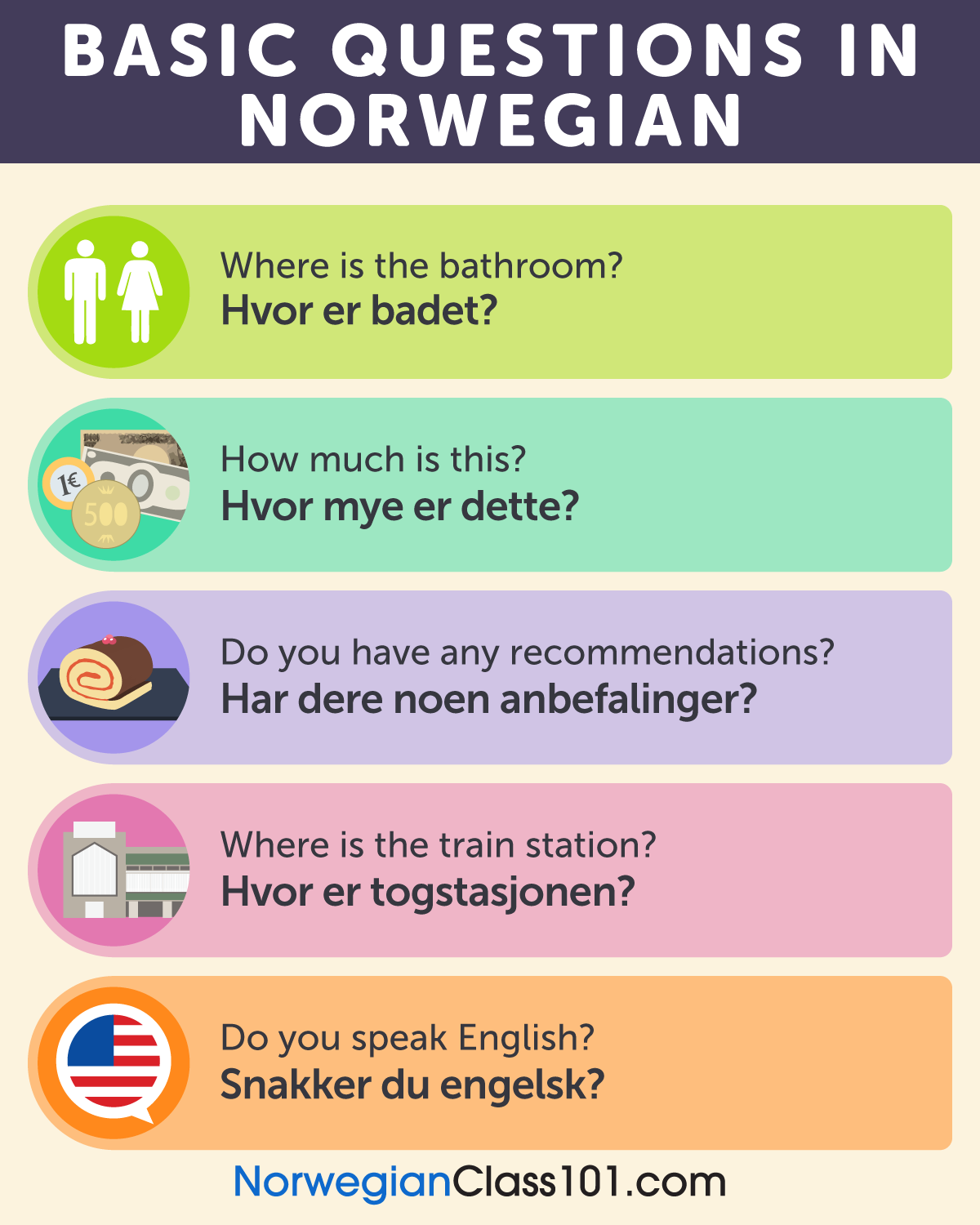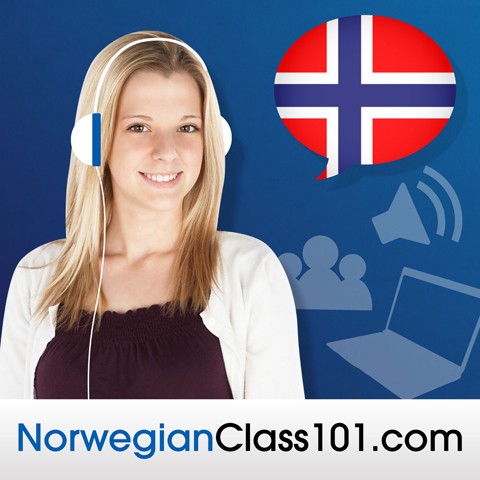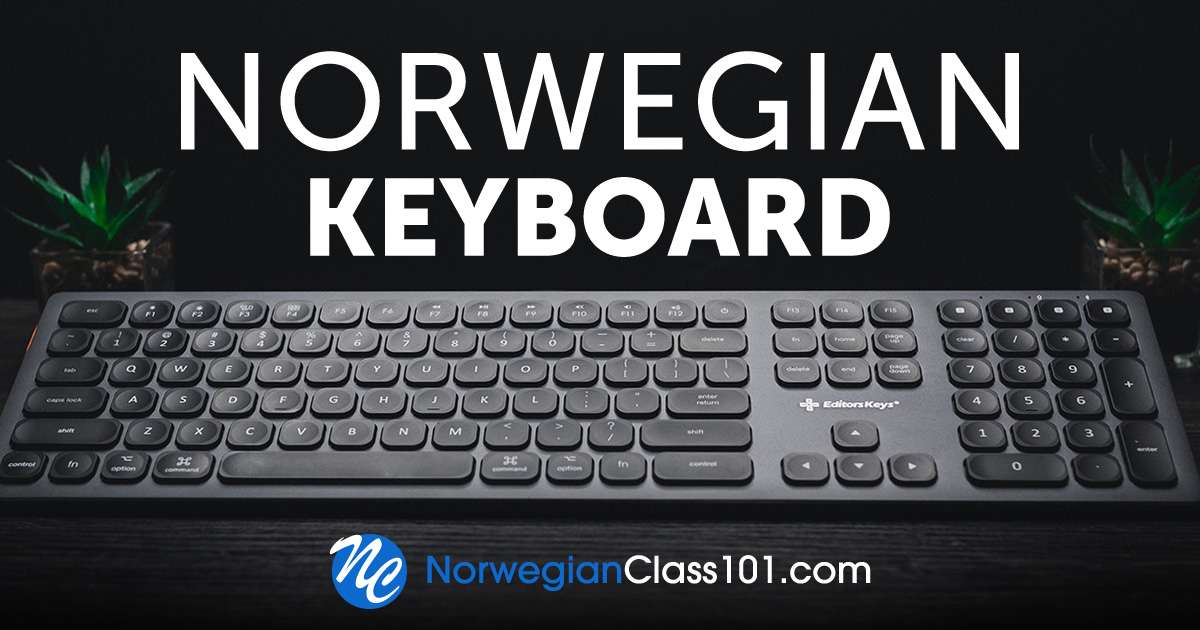
Pronouns play a large part in every language, and Norwegian is no exception. Learning the Norwegian pronouns can seem like a daunting task, especially as a beginner. But don’t worry! Pronouns in Norwegian are similar to those in English, and with some practice, you’ll quickly recognize them.
To be understood properly in Norwegian, it’s important to use the right pronouns. Keep in mind that Norwegian has three grammatical genders: male, female, and neutral. Sometimes certain pronouns will change depending on the gender of the object. How they change also depends on where in Norway you are.
If you’ve read our article on telling time in Norwegian, you already know, for example, that klokke/klokka, meaning “clock,” can be both feminine and masculine in gender. The one you use depends on where you are and who you’re speaking with. This isn’t something you have to worry too much about, especially as a beginner. You’ll learn to recognize the gender of a word with experience!
Further, Norwegian pronouns will also change according to the dialect that is spoken where you are. As you might already know, Norwegian has many dialects. Don’t worry though. It’s only the pronoun that changes, not the grammar. The pronoun “I” is the easiest to notice. Just take a look at how many ways you can say “I”: jeg, eg, æ, e, ej, je, jæ!
We’ll only cover the Norwegian Bokmål version here: jeg. But it’s still good to have some knowledge of all the different ones. Before we begin, also keep in mind that while using the correct pronouns is important, people can still understand you if you accidentally use the wrong one. It can be hard to memorize all of them, but as long as you practice, you’ll soon know them well.
In this article, you’ll learn how to use the correct Norwegian pronouns in sentences, and when talking.
Are you ready? 🙂
 Table of Contents
Table of Contents
- Norwegian Personal Pronouns
- Norwegian Demonstrative Pronouns
- Norwegian Interrogative Pronouns
- Norwegian Indefinite Pronouns
- How NorwegianClass101 Can Help You Learn Even More Norwegian!
1. Norwegian Personal Pronouns

If you’re just starting out, the personal pronouns are the easiest and most important to learn. They’re not that different from the English ones, which is a huge plus! You’ll use these the most, and if you refer to this article, you’ll sound like a native Norwegian in no time!
1- 1st-, 2nd-, and 3rd-Person Singular
Let’s start with the easiest one, which is jeg, meaning “I.” This is one of the most-used pronouns, and you’ll hear and see it often. It’s simple to say, and you can start so many sentences with it. Jeg is very often followed by a verb, as seen in the examples below.
Jeg “I”
Jeg går til butikken. “I’m walking to the shop.”
Jeg spiser mat. “I’m eating food.”
Du, or “you” in English, is another very short and simple pronoun. You’ll find that this goes for most of the pronouns, making them easy to memorize and learn. Like the pronoun jeg, du is often followed by a verb.
Du “You”
Hva spiser du? “What are you eating?”
Du går til butikken. “You’re going to the shop.”
Han, meaning “he” is used the same way as in English.
Han “He”
Han er hyggelig. “He is nice.”
Hva sier han? “What is he saying?”
The same goes for hun, meaning “she.”
Hun “She”
Hun liker mat. “She likes food.”
Hva sa hun? “What did she say?”
Now, the last third-person singular pronoun in Norwegian is den/det, meaning “it” in English. If a noun is masculine or feminine, den is used. If a noun is neutral, det will be used instead.
Den/Det “It”
Liker du den? (f/m) “Do you like it?”
Det er greit. (n) “It’s okay.”
2- 1st-, 2nd-, and 3rd-Person Plural
Good news! The plural personal pronouns are very similar to the English ones! Vi even sounds almost the same. Let’s take a look.
Vi “We”
Vi drar. “We are going.”
Vi skal spise. “We’re going to eat.”
De, meaning “they,” also sounds similar to its English counterpart, making it easy to learn.
De “They”
De vil ikke spise. “They don’t want to eat.”
De vil dra. “They want to go.”
The last one is dere, the equivalent of “you” (plural) in English.
Dere “You”
Dere sovnet tidlig i går. “You fell asleep early yesterday.”
Når dro dere? “When did you go?”
3- Object Form
Norwegian object pronouns, also called the object form, are used the same way as those in English. Easy, right?
Meg is the object form of “I.”
Meg “Me”
Han snakket til meg. “He talked to me.”
Hun elsker meg. “She loves me.”

Dem is the object form of “them.”
Dem “Them”
Han snakker med dem. “He is talking to them.”
Hun elsket dem. “She loved them.”
Last, we have the object form of “you.”
Deg “You”
Jeg elsker deg. “I love you.”
Han elsker deg. “He loves you.”
4- Possessive Forms
Now we’re entering into more advanced territory. Norwegian possessive pronouns can be tricky. In Norwegian, which possessive form you’re using depends on the gender of the object you’re talking about. If you remember what we wrote about Norwegian having three genders—male, female, and neutral—this makes sense. However, as we said, this takes practice and time, so don’t worry if you make a few mistakes along the way.
Let’s have a look at the possessive forms “my” and “mine.”
Min / Mi/ Mitt / Mine “My” / “Mine”
Here, the word bok, meaning “book,” is used in the example. Bok can be both a male and female object. The one you use depends on which one you prefer. Here you’ll see both, and their corresponding possessive forms.
Male
Min “My”
Gi meg boken min. “Give me my book.”
Female
Mi “My”
Gi meg boka mi. “Give me my book.”
Speil, meaning “mirror,” is a neutral word in Norwegian. If you look closely at the sentence below, you’ll notice that the word speil has an -et ending, meaning it’s neutral.
Neutral
Mitt “My”
Gi meg speilet mitt. “Give me my mirror.”
The Norwegian possessive form in the plural form is the same, no matter what gender the word is. It also has the same spelling as in English, although it’s pronounced differently.
Plural
Mine “My” / “Mine”
Gi meg bøkene mine. “Give me my books.”
Bøkene er mine. “The books are mine.”
The possessive forms of “your” and “yours” follow the same rules as those above.
Din /Di /Ditt / Dine “Your” / “Yours”
Male
Din “Your”
Gi meg boken din. “Give me your book.”
Female
Di “Your”
Gi meg boka di. “Give me your book.”
Neutral
Ditt “Your”
Gi meg speilet ditt. “Give me your mirror.”
Plural
Dine “Your” / “Yours”
Gi meg bøkene dine. “Give me your books.”
Dette er dine. “These are yours.”
Then there’s the possessive form of “their.” This possessive form doesn’t change based on gender, so it stays the same.
Deres “Their”
Kan du gi meg nummeret deres? “Can you give me their number?”
Dette er deres mat. “This is their food.”

The possessive form of “its,” “his,” and “hers” will change depending on the gender. First let’s take a look at “its,” which has two different possessive forms.
Dets / Dens “Its”
Dets is used when the noun is neutral. Dens is used when the noun is masculine or feminine.
MASCULINE / FEMININE
Dens arkitektur er vakker. “Its architecture is beautiful.”
NEUTRAL
Legg merke til universet og dets vakre farger. “Notice the universe and its beautiful colors.”
The possessive form “his” in Norwegian is simply the pronoun han, with an added s: hans.
Hans “His”
Øynene hans er grønne. “His eyes are green.”
The possessive form “her(s)” is a little different. Here we use the word hennes.
Hennes “Her(s)”
Øynene hennes er blå. “Her eyes are blue.”
5- Reflexive Forms
Now, let’s move onto Norwegian reflexive pronouns.
The reflexive form of “myself” is almost the same as the pronoun “me” in Norwegian. The only difference is that the word selv is added after, meaning “self.”
Meg selv “Myself”
Jeg har ansvar for meg selv. “I have a responsibility to myself.”
The reflexive form of “yourself” and “yourselves” follows the same structure. You simply use the word deg, which is the object form of “you,” and add selv after it. When it comes to “yourselves,” dere is used instead of deg.
Deg selv “Yourself”
Du må hjelpe deg selv. “You must help yourself.”
Dere selv “Yourselves”
Dere må hjelpe dere selv. “You must help yourselves.”
For the pronouns “himself,” “herself,” and “themselves,” only the word selv is used. This makes it very easy to learn!
Selv “Himself” / “Herself” / “Themselves”
Han/Hun/De må gjør det selv. “He/She/Them have to do it himself/herself/themselves.”
6- Vocabulary
Let’s look at all the pronouns together. Refer to this Norwegian pronouns table when you need some practice!
| Personal Pronouns (Singular) | |
| Jeg | “I” |
| Du | “You” |
| Han | “He” |
| Hun | “She” |
| Den/Det | “It” |
| Personal Pronouns (Plural) | |
| Vi | “We” |
| De | “They” |
| Dere | “You” |
| Object Forms | |
| Meg | “Me” |
| Dem | “Them” |
| Possessive Forms | |
| Min (Male) | “My” |
| Mi (Female) | “My” |
| Mitt (Neutral) | “My” |
| Mine (Plural) | “My” / “Mine” |
| Din (Male) | “Your” |
| Di (Female) | “Your” |
| Ditt (Neutral) | “Your” |
| Dine (Plural) | “Your” / “Yours” |
| Deres | “Their” |
| Meg selv | “Myself” |
| Selv | “Himself” / “Herself” / “Themselves” |
2. Norwegian Demonstrative Pronouns
Demonstrative pronouns are used to specify objects, as well as the distance to objects. Norwegian demonstrative pronouns work the same way as the English ones, so these are quite simple to learn!
1- This and That
In Norwegian, the word for “this” is dette / denne. You probably already know that this means we’ll change which one we use depending on the gender of the object. Dette / denne is used when an object is near.
Dette / Denne “This”
Denne (f/m) “This”
Ta denne boka/boken. “Take this book.”
Dette (neutral) “This”
Ta dette speilet. “Take this mirror.”

Dette er den jeg vil ha. (“This is the one I want.”)
“That” is very simple to learn if you know how to say “this!” The pronouns for “that” are pretty much just short versions of the above Norwegian pronouns. Den / det is used when something is further away.
Det / Den “That”
Den (f/m) “That”
Ta den boka/boken. “Take that book.”
Det (neutral) “That”
Det er et speil. “That is a mirror.”

2- These and Those
Disse, meaning “these,” is used when an object is near and in the plural form.
Disse “These”
Les disse bøkene. “Read these books.”
Can you guess what de means? De is used when an object is far away and in the plural form. You might also notice that de is the same pronoun as the personal pronoun “they.”
De “Those”
Les de bøkene. “Read those books.”
3- Here and There
“Here” and “there” are pretty self-explanatory. The Norwegian demonstrative pronouns for these are, again, very similar to the English ones.
Her “Here”
Bøkene er her. “The books are here.”
Der “There”
Bøkene er der. “The books are there.”
3. Norwegian Interrogative Pronouns

In the Norwegian language, interrogative pronouns are simply called spørreord, meaning “question words.” Again, they’re used in the same way as those in English. In most cases, the Norwegian interrogative pronouns are placed at the beginning of a sentence.
| Norwegian | English | Example | Example translation |
|---|---|---|---|
| Hva | “What” | Hva mener du? | “What do you mean?” |
| Hvorfor | “Why” | Hvorfor sa du det? | “Why did you say that?” |
| Hvilken | “Which” | Hvilken bok har du? | “Which book do you have?” |
| Hvem | “Who” / “Whom” | Hvem sa det? | “Who said that?” |
| Hvem (sine) | “Whose” | Hvem sine bøker er dette? | “Whose books are these?” |
| Hvor | “Where” | Hvor bor du? | “Where do you live?” |
| Hvordan | “How” | Hvordan gjør jeg dette? | “How do I do this?” |
| Når | “When” | Når kommer du hjem? | “When are you coming home?” |
4. Norwegian Indefinite Pronouns

When it comes to indefinite pronouns in Norwegian, it can get a little confusing. In English, most of the indefinite pronouns are just a word. Some of the Norwegian indefinite pronouns are actually phrases. We will, of course, give these some extra attention, so that you can understand what words they’re made up of!
First we have the indefinite pronouns “everyone” / “everybody.” The equivalent in Norwegian is alle sammen. But hang on, it’s not that easy.
Alle can actually mean “everyone” although the direct translation is “all.” Sammen means “together.” However, when someone is using “everyone” / “everybody,” the most common way is to say alle sammen. Alle is more often used when talking about objects, which you’ll see is also the case with the Norwegian indefinite pronoun for “everything.”
Alle sammen “Everyone” / “Everybody”
Kan alle sammen komme hit? “Can everyone/everybody come here?”
Now, let’s look at the indefinite pronoun “everywhere.” In Norwegian, this is overalt. Again, this pronoun is made up of two words. The first is over, which means “over.” The second part is alt, which means “everything.” Does it remind you of alle? That’s because it’s the same word, just conjugated.
Overalt “Everywhere”
Det er rotete overalt! “It’s messy everywhere!”
Considering what you just learned, the word for “everything” should be easy. As we said just above, “everything” in Norwegian is alt. It’s simply a direct translation from English! However, note that it’s very common to add the word sammen, meaning “together,” after it.
Alt (sammen) “Everything”
Du tok alt (sammen)! “You took everything!”
“Someone” / “Somebody” is easy to learn in Norwegian. It’s simply the pronoun noen.
Noen “Someone” / “Somebody”
Har noen en penn? “Does someone/somebody have a pen?”

The word for “somewhere” is a little more complicated again. There are two ways of saying “somewhere.” The shortest version is et sted, meaning “one place.” The longer way of saying it is et eller annet sted, meaning “some place or another.” Both are equally common to say, but et eller annet sted is often used when you really can’t find something and are frantically looking for it.
Et sted/et eller annet sted “Somewhere”
Den må være her et sted. “It has to be here somewhere.”
Den må være her et eller annet sted. “It has to be here somewhere.”
Let’s go from something complicated to something easier! “Something” is simply the word noe. As you can see, it’s very similar to the indefinite pronoun noen, meaning “someone.”
Noe “Something”
Jeg må fortelle deg noe. “I have to tell you something.”
“No one” / “Nobody” is another short and simple word in Norwegian.
Ingen “No one” / “Nobody”
Ingen ringte meg. “No one/Nobody called me.”
“Nowhere” isn’t a specific pronoun in Norwegian, but rather a sentence. Like “somewhere,” there are two ways you can say it. The most common one is Ikke noe sted, directly meaning “not a place.” A less common way is saying inget sted, meaning “no place.”
Ikke noe sted/Inget sted “Nowhere”
Jeg finner den ikke noe sted/inget sted. “It’s nowhere to be found.”
Ingenting means “nothing” in Norwegian. It means “no thing,” exactly like in English.
Ingenting “Nothing”
Vesken har ingenting innvendig. “The purse has nothing inside.”
“Anyone” / “Anybody” is noen in Norwegian. You might be a little confused since we just said noen means “someone” / “somebody.” While we agree it’s a little confusing, there’s really no explanation for this other than that it’s the same word in Norwegian! They’re even pronounced the same way. So it’s one less word you’ll have to practice! 🙂
Noen “Anyone” / “Anybody”
Kan noen fortelle meg hva som skjedde? “Can anyone/anybody tell me what happened?”
“Anywhere” is another sentence in Norwegian: hvor som helst. It doesn’t really have a direct translation to English; it simply means “anywhere.”
Hvor som helst “Anywhere”
Den kan være hvor som helst. “It can be anywhere.”
So what do you think “anything” is? Switch out the hvor with hva, and you have the answer! Hva som helst means “anything” in Norwegian. Again, it’s a sentence without any direct translation to English.
Hva som helst “Anything”
Gi meg hva som helst. “Give me anything.”
5. How NorwegianClass101 Can Help You Learn Even More Norwegian!
Learning Norwegian grammar can be hard, especially if you’re a beginner in the Norwegian language. Norwegian pronouns are easy to learn, but also complicated at times. Like most languages, there can be many rules to remember, but with time, it will get easier. Using good learning resources like NorwegianClass101 will make your Norwegian learning experience a lot easier.
By learning the Norwegian language pronouns, Norwegian possessive forms, and Norwegian indefinite pronouns, you’ll soon learn how to speak like a native. Sounding natural in Norwegian takes dedication and work, but it’s definitely possible!

You can also check out NorwegianClass101 if you want to learn more Norwegian. Here, you can find in-depth articles and vocabulary lists, such as our Most Useful Norwegian Pronouns list! If you’re a beginner, there’s also great information on both Norwegian nouns and the most common Norwegian adjectives. Maybe you need to learn more about Norwegian sentence structure before you can learn the pronouns? Or maybe you want to have an in-depth look at how to tell time or introduce yourself before going further?
NorwegianClass101 has articles and lessons for both beginners and advanced learners, so no matter where you are in your learning curve, you’ll find something that can help you on your way to mastering the Norwegian language.
Before you go, let us know in the comments what you think about the different pronouns! Do you feel more confident now, or are you still struggling with something? To practice, write us a few sentences using different Norwegian pronouns in the comments. 🙂 We look forward to hearing from you!









